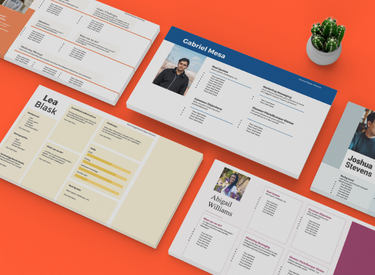As marketers, we know that marketing according to data points alone isn’t enough to get meaningful engagement for your business—that’s the job of a buyer persona.
And, while demographic survey results are great, there are many factors of customer behavior that are needed to create a well-rounded and detailed buyer persona.
Combining different research methods to form a detailed buyer persona is my shining recommendation, and in this post, I’ll show you a research-driven method for creating buyer personas. With just a few thoughtful steps, you’ll walk away with consumer stories and profiles that represent your customer base.
Chapters
According to our research, most marketers lack crucial information about their audience, so they struggle to make personalized content.

Before diving into the buyer persona creation process, let’s pause to understand the impact of well-developed buyer personas on your business (specifically, your marketing efforts).
Why are buyer personas important to your business?
1. Buyer personas help you personalize your marketing.
Personalization is the main reason buyer personas are essential, and it’s only possible when you truly understand your audience. Customers appreciate personalization, as 96% of marketers say it increases the likelihood of buyers becoming repeat customers and 94% say it increases sales.

I don’t know about you, but those stats definitely represent my experience as a consumer. I’m more likely to be a fan of and give repeat business to brands that know what I like and cater to my interests. For example, a brand that sends me an email to tell me that a product on my wishlist is on sale will, more likely than not, turn me into a loyal and repeat customer who even promotes them to my friends.
2. Buyer personas inform product development.
Extensive research into your target customer doesn't only help your marketing functions — these insights have a place in the research and development phase of your product development process.
Understanding what your ideal customer experiences on a day-to-day basis can inspire innovative improvements to your product.
Say, for example, you run a company that sells kitchen utensils and your buyer persona research tells you that your ideal customer lives in the South where grilling is common throughout the year. This could present an opportunity to develop and offer grilling utensils or improve your kitchen utensils so that they work in both indoor and outdoor cooking environments.

Buyer Persona Templates
Organize your audience segments and make your marketing stronger.
- Learn about personas.
- Conduct persona research.
- Create targetted content.
- Build your own personas.
Download Free
All fields are required.

3. Buyer personas enable the optimization of demand generation, lead generation, and lead nurturing content.
Do you know your buyer persona wants to hear from you? One way to find out is through buyer persona research. Understanding how your ideal customer prefers to receive communication can influence your demand generation strategies.
For example, a preference for SMS communication among your target audience can mean you create SMS lead nurturing campaigns instead of emails. You can even justify website changes based on the data you discover from your research.
4. Buyer personas help you tailor your product's messaging its target audience.
Buyer personas help you understand your customers (and prospective customers) better, making it easier for you to tailor your content, messaging, product development, and services to meet your target audience's specific needs, behaviors, and concerns.
For example, you may know your target buyers are caregivers, but do you know the type of care they provide most often? What is the typical background of your ideal buyer? To fully understand what makes your best customers tick, developing detailed personas for your business is critical.
Case in point: marketers who offer customers a personalized experience are 215% more likely to say their marketing strategies are effective than those who don’t.
The strongest buyer personas are based on market research and insights you gather from your actual customer base (through surveys, interviews, etc.). The most common information marketers gather from their audiences is about their interests and hobbies, basic demographic information, and products they’re potentially interested in buying.

Depending on your business, you could have as few as one or two personas or as many as 10 or 20. But if you’re new to personas, start small. You can always develop more personas later if you need them.
What is a negative buyer persona?
While a buyer persona represents your ideal customer, a negative—or exclusionary—persona represents who you don’t want as a customer.
For example, this could include professionals who are too advanced for your product or service, students who only engage with your content for research/ knowledge, or potential customers who are just too expensive to acquire.
The potential customers may be too expensive because of a low average sale price, their propensity to churn, or their unlikeliness to purchase again from your company. This knowledge is valuable because it helps you narrow down your strategic execution so that your inputs directly contribute to your results.
How can buyer personas be used in marketing?
At the most basic level, developing personas allows you to create content and messaging that appeals to your target audience. It also enables you to target or personalize your marketing to different audience segments.
For example, instead of sending the same lead nurturing emails to everyone in your database, you can segment by buyer persona and leverage marketing software solutions, like Marketing Hub, to tailor your messaging to what you know about those different personas. You can then set up various automated email nurturing campaigns — each targeting a specific audience segment.
.
Furthermore, when combined with lifecycle stage (i.e., how far along someone is in your sales cycle), buyer personas also allow you to map out and create highly targeted content. (You can learn more about how to do that by downloading our Content Mapping Template.)
And if you take the time to also create negative personas, you’ll have the added advantage of segmenting out the "bad apples” from the rest of your contacts. This can help you achieve a lower cost-per-lead and cost-per-customer and, therefore, increase sales productivity.
Buyer personas are also an excellent tool if you target a niche audience. I run Breaking the Blueprint, a blog column for minority business owners and entrepreneurs, and the target audience is more specific and granular than that of the general HubSpot Blog (Black entrepreneurs vs. entrepreneurs as a whole, for example).
Sure, I could publish posts based on what I think my target audience would look for and benefit from, but I can create much better content that actually makes an impact and better serves them if I hear from them about their specific interests, needs, and pain points.
Free Buyer Persona Templates
Fill out the form if you want the free kit.
Types of Buyer Personas
While developing your personas, you may ask yourself, "What are the different types of buyer personas?" From there, it'd be simple to adjust one for your business — right?
Well, that's not exactly how it works. Yes, there are standard buyer personas for common demographics, like age groups. Let’s go over some basic examples using data from our State of Consumer Trends Report.
Gen Z
Here are some key stats about Gen Z:
- 64% of Gen Z have discovered a product on social media in the past three months.
- Recommendations from influencers have a stronger impact than those from friends and family.
- Gen Z cares, more than any other generation, that brands stake a stance on social issues, especially about racial justice (47%), LGBTQ+ rights (46%), and climate change (41%).
- Gen Z likes to gather information themselves when researching a product or service (64%)
- Gen Z’s favorite form of content is short-form video. (61%)
Based on their overwhelming desire for brands to take a stand on social issues, I’ll call this example buyer persona Socially Conscious Sam. Here’s how I’d use those stats to create a basic marketing buyer persona based on what she likes and how she wants information.
- Sam spends a lot of time on social media, and it’s where she wants to discover new products or services.
- She’d prefer to research a brand on her own instead of talking to someone from a business, and she’d most likely look for this information on social media.
- She wants to see engaging short-form videos that showcase your brand, especially TikToks and Instagram Reels.
- Sam trusts the influencers and creators that she follows, and the product recommendations and endorsements that they give are a strong influence when she buys products.
- It’s extremely important to Sam that the brands she supports stake a stand on the social issues she cares about, and she wants to know about the causes they support.

Buyer Persona Templates
Organize your audience segments and make your marketing stronger.
- Learn about personas.
- Conduct persona research.
- Create targetted content.
- Build your own personas.
Download Free
All fields are required.

Gen X
Here are some key stats about Gen X.
- Gen X prefers discovering new products on social media and surfing the internet.
- Gen X enjoys and engages the most with images/photos/infographics.
- Overall, Gen X prefers to purchase products from online retailers that sell a variety of brands.
- The quality of a product has the highest influence on Gen X's decision to make a purchase.
- Gen X doesn’t think companies should take a stance on social issues.
I’ll call this person Techy Ted, as he does most of his shopping online. Here’s how I’d turn that research of his preferences into a basic persona.
- Ted prefers to discover new products online through social media and browsing the internet.
- Visually appealing images, photos, and infographics capture his attention, and he spends the most time engaging with them.
- Ted likes the ease of buying from an online retailer (like Amazon) that features a variety of products from different brands.
- Ted values the quality of his products over all else, and he wants access to detailed information about features and benefits. Marketing messages that emphasize this are the most helpful.
- He prefers brand-specific content and doesn’t think his favorite businesses need to take a stance on social issues.
Even with these standard profiles, there is still variation. For example, my mom's generation overwhelmingly prefers images, photos, and infographics, but she loves Instagram Reels more than anyone I know.
Because of this, there isn’t a set of universally recognized buyer personas to choose from, nor is there a standard for the number of personas you need. Every business (no matter how many competitors they have) is unique, so their buyer personas should be unique to them, too.
That’s why identifying and creating your different buyer personas can, at times, be slightly challenging. This is why I recommend using HubSpot's Make My Persona generator (as well as HubSpot's persona templates) to simplify the process of creating different personas.
Just like buyer personas are unique to each company, so is their name for them. You may see buyer personas referred to as “customer personas," "marketing personas," "audience personas," or "target persona.” Each carries the same meaning but will look unique within your company.
Companies may generally have the same (or similar) categories for their buyer personas (e.g., a marketer, an HR rep, an IT manager, etc.). But your business’ personas and the amount you need will depend on your target audience and what you offer your customers.
What goes into persona development?
Now that we’ve discussed the importance of buyer personas and the different types, let’s explore the nuances of developing your buyer personas.
Before you begin creating your buyer personas, you need to identify the people on your team who will have a role in development. Every team has unique experiences with customers that will serve as valuable information for understanding your target audience.
I recommend you involve any customer-facing team member in the process. If you have too many cooks in the kitchen, you can choose one representative from each group or relevant department.
A great place to start is sales and marketing. Sales employees directly communicate with customers, and marketing staff can create data based on information about your customers. Your persona development team should also include an executive leader who will ensure your brand mission and values are upheld through every step of development.
What type of business needs to create buyer personas?
With all that we’ve covered, you might be wondering what types of businesses need to create buyer personas.
The answer is all of them. Every business needs customers or clients, and as long as this is true, buyer personas should be a staple in every business, regardless of the industry.
While developing buyer personas is crucial, reviewing and updating them regularly is equally important. I’d recommend doing this annually. I know this sounds tedious, but staying on top of your target audience and how their preferences may evolve ensures you’re always ready to meet their needs and helps you secure them as future repeat customers.
Do you feel ready to start creating your buyer personas? Let's dive in.
How to Create a Buyer Persona In 4 Steps
You can create buyer personas through research, surveys, and interviews — all with a mix of customers, prospects, and those outside your contacts database who might align with your target audience. In any case, your buyer personas must be based on concrete evidence regarding your audience’s interests, behavior, and demographics.
While creating personas for Breaking the Blueprint, I discovered some helpful and practical methods for gathering the information you need to develop personas (you can also further your knowledge on this topic through the free HubSpot Academy course):
- Look through your contacts database to uncover trends about how certain leads or customers find and consume your content.
- Use form fields that capture important persona information when creating forms to use on your website. For example, if all of my personas vary based on company size, I'd ask each lead for information about company size in the forms.
- Check your website traffic analytics to identify useful information about your existing audience, like demographics, which pages attract the most visitors and why, or what marketing campaigns drive the most traffic.
- Consider your sales team's feedback on the leads they interact with most. What generalizations can you make about the different types of customers you serve best?
- Interview customers and prospects to discover what they like about your product or service.
Now, how can you use the above research to create your personas?
Once you've gone through the research process, you'll have a lot of meaty, raw data about your potential and current customers. But what do you do with it? How do you distill all of it so it's easy for everyone to understand all the information you've gathered?
The next step is to use your research to identify patterns and commonalities from the answers to your interview questions, develop at least one primary persona, and share that persona with the rest of the company.
You can use our free, downloadable persona template to organize the information you've gathered about your persona(s) and share it with relevant stakeholders so everyone can develop an in-depth understanding of the people they’re targeting at work.
Let’s work through the steps involved in creating a buyer persona in more detail.
1. Fill in your persona's basic demographic information.
Ask demographic-based questions over the phone, in person, or with online surveys. Keep in mind that some people are more comfortable disclosing personal information in private, or some might not want to at all, so it’s a best practice to make this optional unless it’s a pivotal part of your buyer persona.
If you're having conversations, I find it helpful to include descriptive buzzwords and mannerisms of your persona you may pick up on to make it easier for people on your team to identify certain personas when talking to prospects.
Here's an example of how you might complete Section 1 in your template for one of your personas: 
2. Share what you've learned about your persona's motivations.
This is where you'll distill the information you learned from asking "why" during those interviews. What keeps your persona up at night? Who do they want to be? Most importantly, tie that all together by telling people how your company can help them.
3. Help your sales team prepare for conversations with your persona.
The personas I’ve created are more helpful and impactful when I include real quotes from interviews that exemplify what my audience is concerned about, who they are, and what they want.
You can also create a list of the objections they might raise so your sales team can prepare to address those during conversations with prospects.
4. Craft messaging for your persona.
Tell people how to talk about your products/ services with your persona. This includes the nitty-gritty vocabulary you should use and a more general elevator pitch that positions your solution in a way that resonates with your persona.
This will help you ensure everyone in your company speaks the same language when conversing with leads and customers.
Finally, make sure you give your persona a name (e.g., Finance Manager Margie, IT Ian, or Landscaper Larry), so everyone internally refers to each persona the same way, allowing for cross-team consistency.
And if you're a HubSpot customer, you can easily add your persona to Marketing Hub by following this step-by-step setup guide.

Buyer Persona Templates
Organize your audience segments and make your marketing stronger.
- Learn about personas.
- Conduct persona research.
- Create targetted content.
- Build your own personas.
Download Free
All fields are required.

How to Find Interviewees for Researching Buyer Personas
One of the most critical steps to establishing your buyer persona(s) is finding people to speak with to understand, well, who your buyer persona is.
But how do you find these interviewees? There are a few sources you can tap into.
1. Use your current customers.
Your existing customer base is the perfect place to start your interviews because they've already purchased your product and engaged with your company. At least some of them are likely to exemplify your target persona(s).
Don't just talk to people who love your product and want to spend an hour gushing about you (as good as that feels). Customers who are unhappy with your product will show other patterns that will help you form a solid understanding of your personas.
For example, you might find that some of your less happy customers have bigger teams and need greater collaboration functionality from your product. Or, you may find they find your product too technical and difficult to use. In both cases, you learn something about your product and what your customers' challenges are.
Another benefit of interviewing current customers is that you may not need to offer them an incentive (e.g., gift cards). Customers like being heard, and interviewing them gives them a chance to tell you about their world, their challenges, and what they think of your product.
Customers also like to have an impact on the products they use. So, as you involve them in interviews like this, you may find they become even more loyal to your company. When you reach out to customers, be clear that your goal is to get their feedback and that you highly value it.
2. Use your prospects.
You can also interview people who have not purchased your product and know little about your brand. Your prospects and leads are great options because you already have their contact information.
Use the data you do have about them (i.e., anything you've collected through lead generation forms or website analytics) to figure out who might fit into your target personas. Tools like Enlyft can help you create custom buyer persona profiles and match your prospects to them to make it easier to find the people you need to talk to.
3. Use your referrals.
You might need to rely on referrals to talk to people who may fit into your target personas, particularly if you're heading into new markets or don't have any leads or customers yet.
Use your network (coworkers, existing customers, social media contacts, etc.) to find people you'd like to interview and be introduced to. Getting a large volume of people with this method can be tough, but you'll likely get some very high-quality interviews out of it.
If you don't know where to start, I suggest searching on LinkedIn for people who may fit into your target personas and seeing who you share connections with, and reaching out to them for introductions.
4. Use third-party networks.
For interviewees completely removed from your company, you can recruit from third-party networks. For example, Craigslist lets you post ads for people interested in any job, and UserTesting.com lets you to run remote user testing.
You'll have less control over sessions run through UserTesting.com, but it's a great resource for quick user testing recruiting.
Now that you know how to find interviewees, I'll go over some tips for recruiting them.
Tips for Recruiting Buyer Persona Interviewees
As you reach out to potential buyer persona interviewees, here are a few ideas to improve your response rates.
1. Use incentives.
Incentives give people a reason to participate if they don’t already have a relationship with you. You probably don’t need them in every scenario (e.g., customers who already want to talk to you), but a simple gift card is an easy option.
2. Be clear that this isn't a sales call.
Be clear that you’re not making a sales call. This is especially important when dealing with non-customers who might be wary of getting stuck on a sales call. Explain that you’re doing research and want to learn from them, not committing them to a sales call. You're getting them to commit to telling you about their lives, jobs, and challenges.
3. Make it easy to say yes.
Take care of everything for your potential interviewee. Suggest times, but be flexible so they can pick what works best for them.
4. Decide how many people you need to interview.
How many people do you need to interview to create a well-rounded persona?
I wish I could give you a set number, but my answer is that it depends. Start with at least three to five interviews for each persona you create. That may be enough if you already know a lot about your persona.
You may need multiple interviews with each category of interviewees (customers, prospects, people who don’t know your company). You’ll naturally notice patterns throughout your conversations, but a good rule of thumb is to call it if you start predicting what they’ll say.
5. Determine which questions you'll ask interviewees.
It's time to conduct the interview! After the normal small talk and thank yous, it's time to jump into your questions. You’ll want to ask several categories of questions during persona interviews to create a complete persona profile, from personal background questions, to questions about goals and challenges in their current role.

Buyer Persona Templates
Organize your audience segments and make your marketing stronger.
- Learn about personas.
- Conduct persona research.
- Create targetted content.
- Build your own personas.
Download Free
All fields are required.

Buyer Persona Examples
Let's go over some examples of completed buyer personas to get a better understanding of what they look like.
B2B Buyer Persona Example
The image below is a B2B buyer persona for someone who works in HR. The persona paints a clear picture of the target customer's struggles and how the business can best meet those needs. In this case, HR recruiting tools streamline processes, make recruiting easier, and help HR expertly manage their overall job duties.

B2C Buyer Persona Example
The image below is a B2C buyer persona for a music streaming service.

Based on this persona, a streaming service would want to ensure that it has a user-friendly mobile app, sends new music notifications, and makes it easy for users to discover new music related to their interests and share content with friends.
Create Your Buyer Personas
Creating buyer personas helps you understand your target customers on a deeper level and ensures everyone on your team knows how to best target, support, and work with your customers. When you use your personas to guide decisions, I don’t doubt that you’ll see improvement in your reach, boost your conversions, and increase customer loyalty.
Editor's note: This post was originally published in May 2015 and has been updated for comprehensiveness.







![Blog - Buyer Persona Template [Updated]](https://no-cache.hubspot.com/cta/default/53/b9eb5e3d-dd13-4f36-9b7f-1ea13e714da2.png)


![20 Best Buyer Persona Questions to Ask Customers [Free Template]](https://53.fs1.hubspotusercontent-na1.net/hubfs/53/buyer%20persona%20questions.jpg)
![The Definition of a Buyer Persona [in Under 100 Words]](https://www.hubspot.com/hubfs/a%20woman%20buyer%20persona.jpg)





